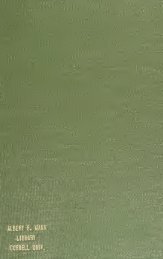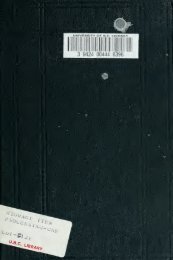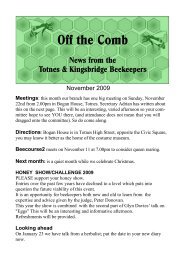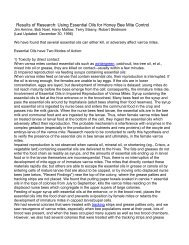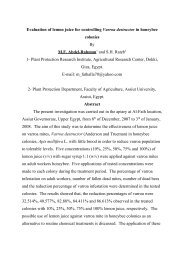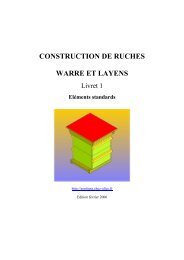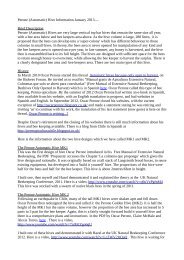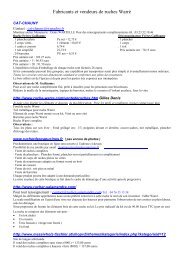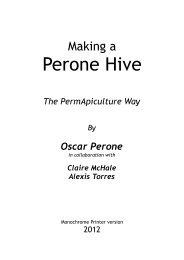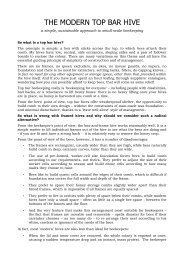Create successful ePaper yourself
Turn your PDF publications into a flip-book with our unique Google optimized e-Paper software.
Observation<br />
Explanation<br />
<strong>At</strong> <strong>the</strong> start of <strong>the</strong> main flow<br />
groups of bees block <strong>the</strong> hive<br />
entrance.<br />
This situation, annoying at this time of <strong>the</strong> year, i!<br />
caused by over-population. These colonies lose <strong>the</strong><br />
inclination and dedication to work even if <strong>the</strong>y are<br />
not yet affected by <strong>the</strong> swarming fever. Their inclina<br />
tion to work is restored by removing as soon as possi<br />
ble young bees and <strong>the</strong> frames containing sealec<br />
brood (formation of artificial swarms).<br />
Blockage occurs at <strong>the</strong> hive<br />
entrances of certain colonies<br />
due to bees entering and leaving.<br />
Numerous pollen pellets of all<br />
colours litter <strong>the</strong> alighting<br />
board and bottom board of <strong>the</strong><br />
hive.<br />
To what does one attribute <strong>the</strong><br />
"smoothing" movements that<br />
certain of <strong>the</strong> bees make before<br />
<strong>the</strong> hive entrance?<br />
The hive entrance is too narrow. The fanners block i<br />
and those going out obstruct <strong>the</strong> return of heavily loa<br />
ded bees. In <strong>the</strong> long run this wasting of time result<br />
in a decrease in <strong>the</strong> harvest.<br />
The hive entmnoe is too narrow and its ridges ,J<br />
sharp. On entering <strong>the</strong> hive <strong>the</strong> bees scrape <strong>the</strong>msejlves<br />
and lose <strong>the</strong>ir pollen.<br />
To find <strong>the</strong> cause of <strong>the</strong>se movements, which are<br />
particularly evident when <strong>the</strong> pollen harvest is plentiful,<br />
I used a magnifying glass to observe bees buzy<br />
"smoothing", without disturbing <strong>the</strong>m. Only in a few<br />
cases did <strong>the</strong>y continue <strong>the</strong>ir movements. Thanks to<br />
<strong>the</strong> magnifying glass I could ascertain that small pollen<br />
particles, invisible to <strong>the</strong> naked eye, remained attached<br />
to <strong>the</strong> bees hair. These were certainly not young<br />
bees but foragers.<br />
The colony I was watching was harvesting an unusually<br />
large amount of pollen. Whilst in o<strong>the</strong>r colonies<br />
I saw few or no bees "smoothing", in this one it was<br />
frequent especially when <strong>the</strong> pollen was plentiful.<br />
Finally, I concluded that <strong>the</strong> bees made <strong>the</strong>se movements,<br />
which sometimes continued a long time, to rid<br />
<strong>the</strong>mselves of <strong>the</strong>se minute pollen grains, which slide<br />
into <strong>the</strong> gap between <strong>the</strong> head and <strong>the</strong> thorax, and<br />
can be particularly uncomfortable and annoying.<br />
34<br />
I



